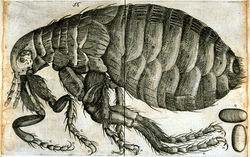Filippo Bonanni

Filippo Bonanni, S.J., or Buonanni (1638 – 1723) was Italian Jesuit scholar. Among his many works of erudition were treatises on fields ranging from anatomy to music. He also published a study of lacquer which has been of lasting value since his death.
Life
Bonanni was born in Rome in 1638, and entered the Society of Jesus in 1654, when he was still 17 years old. After his novitiate, in 1656 he was sent to study at the Society's noted Roman College. There he became a pupil of the German scientist, Athanasius Kircher. While a student there, he undertook the manufacturing of microscopic lenses. He used his lenses to develop scientific studies of a number of specimens.
From Rome, Bonanni was sent to teach in the Jesuit Colleges of Orvieto and Ancona. Upon Kircher's resignation of the post of Professor of Mathematics at the Roman College, Bonanni was chosen to succeed him.
After Kircher's death in 1698, Bonanni was appointed curator of the well-known cabinet of curiosities (collection of antiquities) gathered by Kircher and installed in the Roman College. He published a catalogue of the collection in 1709, titled Musæum Kicherianum.
In this work, among other topics, Bonanni wrote of the ingredients used in China for the manufacture of the lacquer used on the porcelain which was a popular import item for Europe at the time. Like other researchers of the day, he went on to experiment with various recipes to recreate the lacquer used on porcelain and furniture. In 1720, Bonanni published his studies in a Treatise on the Varnish commonly called Chinese. This work was republished repeatedly over the next century in several languages, and was re-issued in 1994 in its original Italian version.[1]
Scientific work
Bonanni was an ecclesiastic without true scientific training or experience but he made excellent observations embodied in several works:
- Ricreatione dell' occhio e della mente.
Bonanni was a shell collector and was the author of the first book devoted solely to seashells, published in Rome in 1681. Several later Linnaean names were based on his illustrations.[2]

- Observationes circa Viventia, quae in Rebus non Viventibus
Using a three lens microscope, in this work published in 1691 Bonanni tried to show that spontaneous generation was possible in animals "without blood and a heart", in contradiction of Francesco Redi’s experimental work. The compilation of knowledge and quality of the illustrations made this an important work.
- Numismata Pontificum Romanorum
A two-volume study published in 1699 of the coins issued by the papacy over the centuries.
- Musæum Kircherianum, sive Musaeum a P. Athanasio Kirchero in Collegio Romano Societatis Jesu... descriptum
The catalogue of Kircher's collection (1709).
- Trattato sobre la vernice detta communemente Cinese
His work on lacquer, published 1720.
- Gabinetto Armonico
Issued in 1723, it is a splendid collection of 150 engravings of musical instruments from around the world.
References
- ↑ Perugini, Flavia (2009). Techniques of Chinese Lacquer: The classic eighteenth-century Treatise on Asian Varnish. Los Angeles: J. Paul Getty Trust.
- ↑ Buonanni's Chiocciole (1681)
|